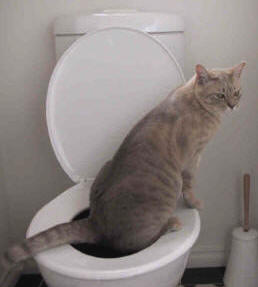Dangers of Flushing Cat Poop Down Your Toilet - Avoid Potential Issues
Dangers of Flushing Cat Poop Down Your Toilet - Avoid Potential Issues
Blog Article
Everybody is bound to have their own individual piece of advice in relation to Can You Flush Cat Poo or Litter Down the Toilet?.

Introduction
As feline proprietors, it's vital to bear in mind just how we deal with our feline buddies' waste. While it may seem hassle-free to purge cat poop down the bathroom, this technique can have damaging repercussions for both the atmosphere and human health and wellness.
Ecological Impact
Flushing cat poop presents unsafe pathogens and parasites into the water supply, positioning a significant threat to aquatic environments. These contaminants can adversely influence aquatic life and concession water quality.
Health and wellness Risks
Along with environmental concerns, purging feline waste can also position health threats to human beings. Feline feces might contain Toxoplasma gondii, a bloodsucker that can cause toxoplasmosis-- a possibly severe ailment, especially for expectant females and individuals with weakened immune systems.
Alternatives to Flushing
Fortunately, there are safer and much more liable ways to get rid of feline poop. Take into consideration the complying with options:
1. Scoop and Dispose in Trash
The most common approach of disposing of cat poop is to scoop it into a naturally degradable bag and toss it in the trash. Make certain to make use of a dedicated litter inside story and deal with the waste immediately.
2. Use Biodegradable Litter
Select eco-friendly pet cat litter made from products such as corn or wheat. These trashes are eco-friendly and can be safely taken care of in the trash.
3. Hide in the Yard
If you have a yard, think about hiding cat waste in a marked location far from vegetable yards and water sources. Be sure to dig deep sufficient to avoid contamination of groundwater.
4. Install a Pet Waste Disposal System
Purchase an animal waste disposal system particularly designed for pet cat waste. These systems use enzymes to break down the waste, reducing smell and ecological influence.
Final thought
Responsible pet dog possession prolongs beyond giving food and sanctuary-- it additionally entails appropriate waste management. By avoiding flushing feline poop down the bathroom and choosing alternative disposal techniques, we can reduce our ecological footprint and protect human health and wellness.
Why Can’t I Flush Cat Poop?
It Spreads a Parasite
Cats are frequently infected with a parasite called toxoplasma gondii. The parasite causes an infection called toxoplasmosis. It is usually harmless to cats. The parasite only uses cat poop as a host for its eggs. Otherwise, the cat’s immune system usually keeps the infection at low enough levels to maintain its own health. But it does not stop the develop of eggs. These eggs are tiny and surprisingly tough. They may survive for a year before they begin to grow. But that’s the problem.
Our wastewater system is not designed to deal with toxoplasmosis eggs. Instead, most eggs will flush from your toilet into sewers and wastewater management plants. After the sewage is treated for many other harmful things in it, it is typically released into local rivers, lakes, or oceans. Here, the toxoplasmosis eggs can find new hosts, including starfish, crabs, otters, and many other wildlife. For many, this is a significant risk to their health. Toxoplasmosis can also end up infecting water sources that are important for agriculture, which means our deer, pigs, and sheep can get infected too.
Is There Risk to Humans?
There can be a risk to human life from flushing cat poop down the toilet. If you do so, the parasites from your cat’s poop can end up in shellfish, game animals, or livestock. If this meat is then served raw or undercooked, the people who eat it can get sick.
In fact, according to the CDC, 40 million people in the United States are infected with toxoplasma gondii. They get it from exposure to infected seafood, or from some kind of cat poop contamination, like drinking from a stream that is contaminated or touching anything that has come into contact with cat poop. That includes just cleaning a cat litter box.
Most people who get infected with these parasites will not develop any symptoms. However, for pregnant women or for those with compromised immune systems, the parasite can cause severe health problems.
How to Handle Cat Poop
The best way to handle cat poop is actually to clean the box more often. The eggs that the parasite sheds will not become active until one to five days after the cat poops. That means that if you clean daily, you’re much less likely to come into direct contact with infectious eggs.
That said, always dispose of cat poop in the garbage and not down the toilet. Wash your hands before and after you clean the litter box, and bring the bag of poop right outside to your garbage bins.
https://trenchlesssolutionsusa.com/why-cant-i-flush-cat-poop/

Do you like more info about How to Dispose of Cat Poop and Litter Without Plastic Bags? Write a remark down below. We will be delighted to know your opinions about this piece. We hope to see you back again in the near future. Are you aware of somebody who is excited by the subject? Do not hesitate to promote it. Thanks for your time. Kindly come by our blog back soon.
Check It Out Report this page